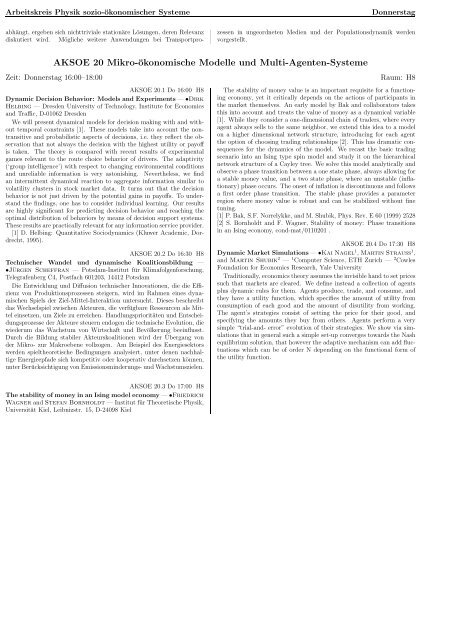Arbeitskreis Physik sozio-ökonomischer Systeme ... - DPG-Tagungen
Arbeitskreis Physik sozio-ökonomischer Systeme ... - DPG-Tagungen
Arbeitskreis Physik sozio-ökonomischer Systeme ... - DPG-Tagungen
Create successful ePaper yourself
Turn your PDF publications into a flip-book with our unique Google optimized e-Paper software.
<strong>Arbeitskreis</strong> <strong>Physik</strong> <strong>sozio</strong>-<strong>ökonomischer</strong> <strong>Systeme</strong> Donnerstag<br />
abhängt, ergeben sich nichttriviale stationäre Lösungen, deren Relevanz<br />
diskutiert wird. Mögliche weitere Anwendungen bei Transportpro-<br />
zessen in ungeordneten Medien und der Populationsdynamik werden<br />
vorgestellt.<br />
AKSOE 20 Mikro-ökonomische Modelle und Multi-Agenten-<strong>Systeme</strong><br />
Zeit: Donnerstag 16:00–18:00 Raum: H8<br />
AKSOE 20.1 Do 16:00 H8<br />
Dynamic Decision Behavior: Models and Experiments — •Dirk<br />
Helbing — Dresden University of Technology, Institute for Economics<br />
and Traffic, D-01062 Dresden<br />
We will present dynamical models for decision making with and without<br />
temporal constraints [1]. These models take into account the nontransitive<br />
and probabilistic aspects of decisions, i.e. they reflect the observation<br />
that not always the decision with the highest utility or payoff<br />
is taken. The theory is compared with recent results of experimental<br />
games relevant to the route choice behavior of drivers. The adaptivity<br />
(‘group intelligence’) with respect to changing environmental conditions<br />
and unreliable information is very astonishing. Nevertheless, we find<br />
an intermittent dynamical reaction to aggregate information similar to<br />
volatility clusters in stock market data. It turns out that the decision<br />
behavior is not just driven by the potential gains in payoffs. To understand<br />
the findings, one has to consider individual learning. Our results<br />
are highly significant for predicting decision behavior and reaching the<br />
optimal distribution of behaviors by means of decision support systems.<br />
These results are practically relevant for any information service provider.<br />
[1] D. Helbing: Quantitative Sociodynamics (Kluwer Academic, Dordrecht,<br />
1995).<br />
AKSOE 20.2 Do 16:30 H8<br />
Technischer Wandel und dynamische Koalitionsbildung —<br />
•Jürgen Scheffran — Potsdam-Institut für Klimafolgenforschung,<br />
Telegrafenberg C4, Postfach 601203, 14412 Potsdam<br />
Die Entwicklung und Diffusion technischer Innovationen, die die Effizienz<br />
von Produktionsprozessen steigern, wird im Rahmen eines dynamischen<br />
Spiels der Ziel-Mittel-Interaktion untersucht. Dieses beschreibt<br />
das Wechselspiel zwischen Akteuren, die verfügbare Ressourcen als Mittel<br />
einsetzen, um Ziele zu erreichen. Handlungsprioritäten und Entscheidungsprozesse<br />
der Akteure steuern endogen die technische Evolution, die<br />
wiederum das Wachstum von Wirtschaft und Bevölkerung beeinflusst.<br />
Durch die Bildung stabiler Akteurskoalitionen wird der Übergang von<br />
der Mikro- zur Makroebene vollzogen. Am Beispiel des Energiesektors<br />
werden spieltheoretische Bedingungen analysiert, unter denen nachhaltige<br />
Energieepfade sich kompetitiv oder kooperativ durchsetzen können,<br />
unter Berücksichtigung von Emissionsminderungs- und Wachstumszielen.<br />
AKSOE 20.3 Do 17:00 H8<br />
The stability of money in an Ising model economy — •Friedrich<br />
Wagner and Stefan Bornholdt — Institut für Theoretische <strong>Physik</strong>,<br />
Universität Kiel, Leibnizstr. 15, D-24098 Kiel<br />
The stability of money value is an important requisite for a functioning<br />
economy, yet it critically depends on the actions of participants in<br />
the market themselves. An early model by Bak and collaborators takes<br />
this into account and treats the value of money as a dynamical variable<br />
[1]. While they consider a one-dimensional chain of traders, where every<br />
agent always sells to the same neighbor, we extend this idea to a model<br />
on a higher dimensional network structure, introducing for each agent<br />
the option of choosing trading relationships [2]. This has dramatic consequences<br />
for the dynamics of the model. We recast the basic trading<br />
scenario into an Ising type spin model and study it on the hierarchical<br />
network structure of a Cayley tree. We solve this model analytically and<br />
observe a phase transition between a one state phase, always allowing for<br />
a stable money value, and a two state phase, where an unstable (inflationary)<br />
phase occurs. The onset of inflation is discontinuous and follows<br />
a first order phase transition. The stable phase provides a parameter<br />
region where money value is robust and can be stabilized without fine<br />
tuning.<br />
[1] P. Bak, S.F. Norrelykke, and M. Shubik, Phys. Rev. E 60 (1999) 2528<br />
[2] S. Bornholdt and F. Wagner, Stability of money: Phase transitions<br />
in an Ising economy, cond-mat/0110201 .<br />
AKSOE 20.4 Do 17:30 H8<br />
Dynamic Market Simulations — •Kai Nagel 1 , Martin Strauss 1 ,<br />
and Martin Shubik 2 — 1 Computer Science, ETH Zurich — 2 Cowles<br />
Foundation for Economics Research, Yale University<br />
Traditionally, economics theory assumes the invisible hand to set prices<br />
such that markets are cleared. We define instead a collection of agents<br />
plus dynamic rules for them. Agents produce, trade, and consume, and<br />
they have a utility function, which specifies the amount of utility from<br />
consumption of each good and the amount of disutility from working.<br />
The agent’s strategies consist of setting the price for their good, and<br />
specifying the amounts they buy from others. Agents perform a very<br />
simple “trial-and- error” evolution of their strategies. We show via simulations<br />
that in general such a simple set-up converges towards the Nash<br />
equilibrium solution, that however the adaptive mechanism can add fluctuations<br />
which can be of order N depending on the functional form of<br />
the utility function.
















